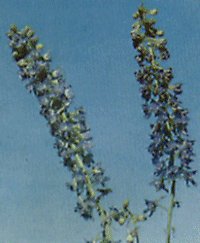LARKSPUR


Description
Tall larkspur has a spurred blue flower, similar to that of garden delphinium. Broad leaves are divided into deep lobes. In contrast, wild geranium-which often is mistaken for larkspur in its early growth-has shallow leaf lobes.
The tall is found in thick clusters on hillsides and in meadows. It grows about 5 feet tall. A hollow stem distinguishes larkspur from poisonous monkshood, which has similar blue flower without a spur. Larkspur is a perennial in the crowfoot family.
Low larkspur has spurred blue flowers that grow on the top third of a single, unbranched stem.
The low larkspur is found on grassy hillsides and in sagebrush areas. It may reach a height of 2 feet. Leaves
alternate and are divided into deep, narrow lobes. The stem is hollow.

Larkspur probably causes more cattle losses in western range States than any other poisonous plants. Because cattle will feed on larkspur even when food forage is available, losses are apt to be heavy if cattle are allowed on larkspur-infested ranges.
Losses rarely occur in sheep or horses.
All species of larkspur are poisonous. Plants are commonly called tall larspur and low larkspur, depending on their size and growth habit.
Tall larkspur reaches a poisonous peak during early summer. Toxicity decreases after flowering, but plants continue to be dangerous until after matureity in the fall. Low larkspur is especially poisonous through flowering; it remains toxic until leaves dry.
The toxic substances are alkaloids; the most common of these is delphinine.

Where and When It Grows
Larkspur is an invader. Unless it is controlled, it crowds desirable forage off higher ranges.
The tall grows at elevations of 6,000 to 11,000 feet. It is common in moist areas on mountain ranges, under aspen, and along streams. Tall larkspur usually starts growth in May or June.
Low larkspur is found on open hillsides and in parks at elevations up to 10,000 feet. It is common on foothills and sagebrush ranges.
Low begins growing in early spring. After it matures in June or early July, the leaves dry up and the danger to livestock decreases.

Hoe It Affects Livestock
An animal may be poisoned if it eats a relatively small amount of larkspur in a short period. One-fourth pound of the more toxic species per 100 pounds of animal weight may cause death.

Signs of poisoning:
1. Nervousness
2. Staggering and falling
3. Nausea
4. Excessive salivation
5. Frequent swallowing
6. Twitching muscles
7. Bloating
8. Rapid, irregular heart action
9. Respiratory paralysis

BACK TO INDEX
H O M E
Would You Consider Signing
My Book?










